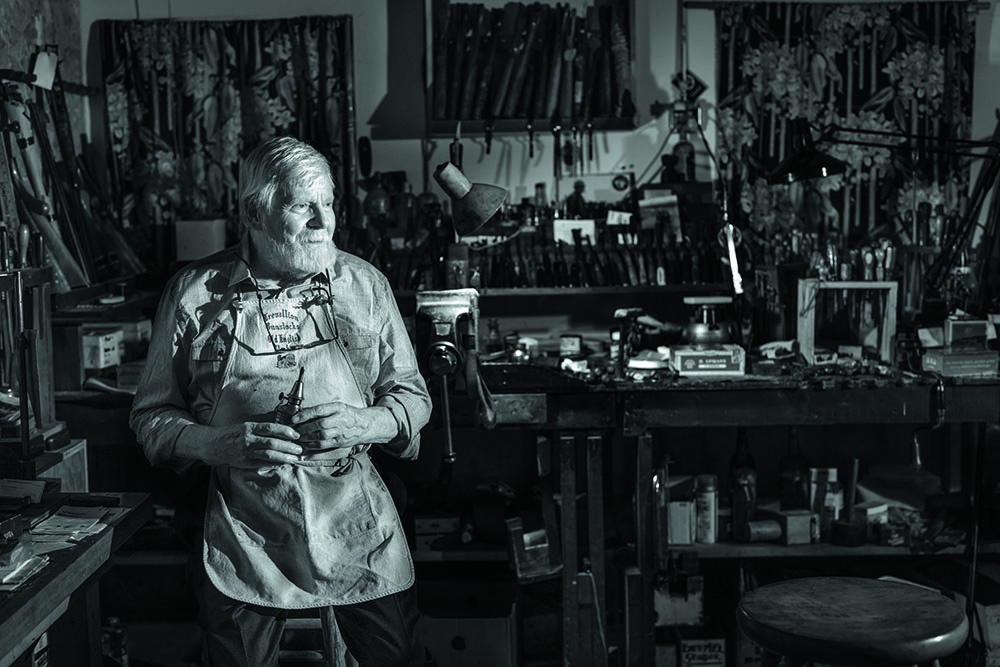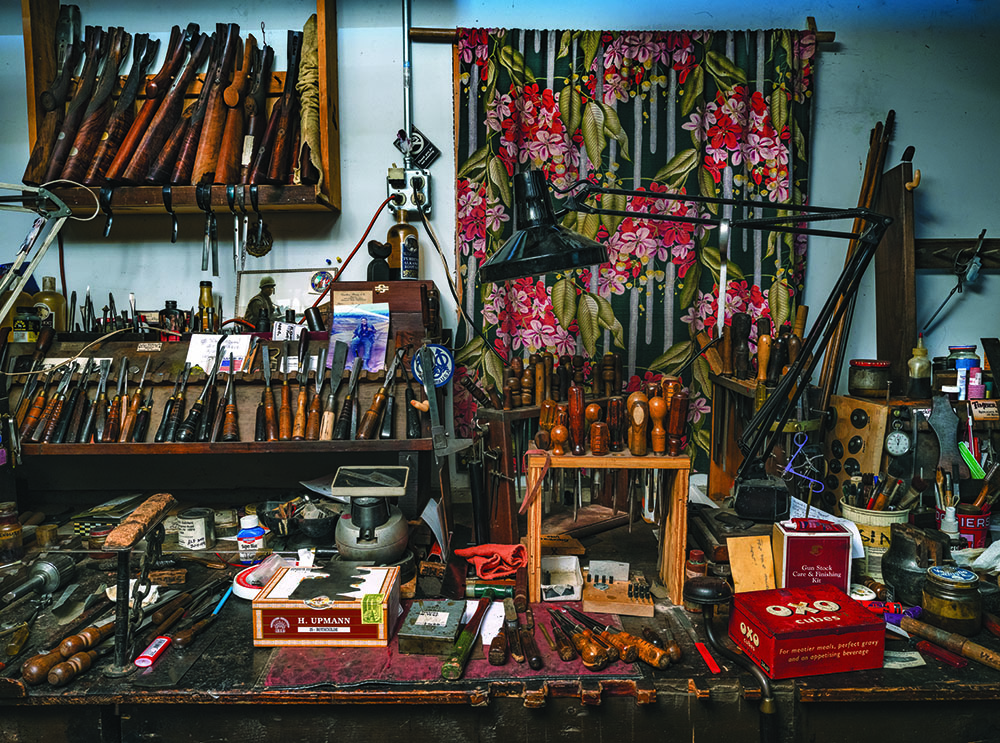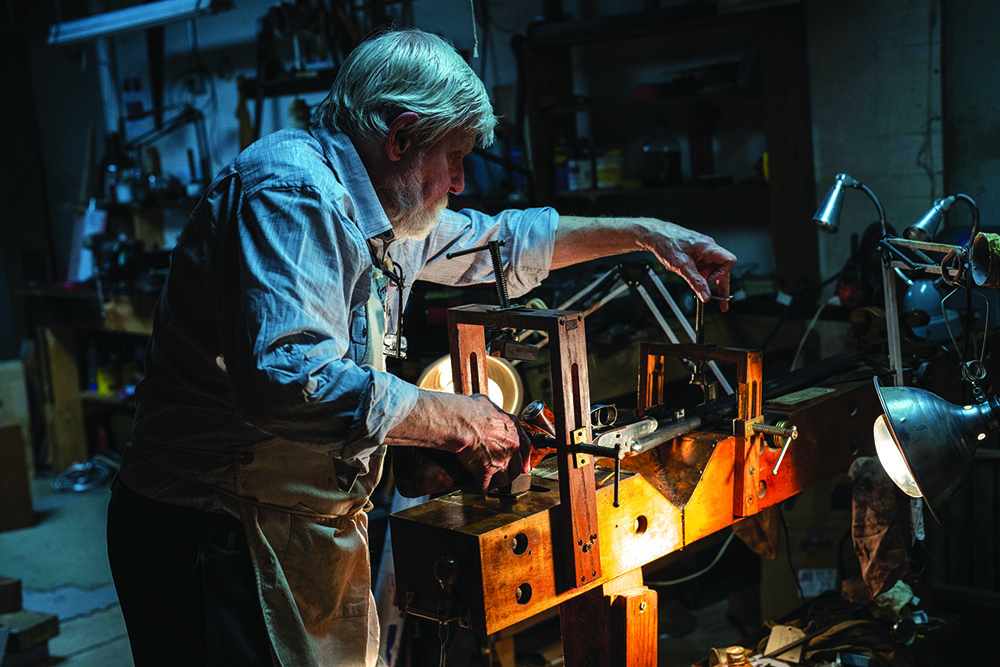Twinkle in his Eye

David Trevallion was born on July 18, 1938, in Marylebone—as he likes to say, “barely a hundred yards from Purdey’s,” that is, from Audley House, the historic headquarters of James Purdey & Sons Gun & Rifle Makers, in London. It was more like 300 yards, but no matter. This made him officially a Cockney, as anyone realizes as soon as David opens his mouth. Although he has lived in the United States for 57 years now, the classic London working-man’s accent is unmistakable. If David slipped into rhyming slang, we might think we were in an off-Broadway rehearsal for My Fair Lady.
Accents are said to disappear or change if a child relocates before the age of 12, and Trevallion was 26 when he came to America. So the linguistic die was cast, and David, an individualist’s individualist, is not one to take on camouflage of any sort. He is who he is—and, of course, the accent suits an English gunmaker right down to the ground, particularly in America. It’s almost a marketing gimmick.
By “gunmaker” I mean someone who truly makes guns—one at a time, by hand, with files and chisels, a smoke lamp, and a trained eye. These are not machine operators and not the suits out front who hobnob with clients on their grouse moors, but the blokes with grimy fingernails and stubbled cheeks who may never have fired a gun in their lives. That was not unusual when Trevallion became an apprentice to the trade in July 1953, just as he turned 15. England was still the nation of black-and-white newsreels then, London could still be choked by noxious fogs, and in the countryside servants still scurried when the lady at the big house wanted her horse brought around. It was the end days of “Downton Abbey”—just not so warm-toned and romantic.
Trevallion’s father had returned from the war to tend bar at the Grenadier Pub and to drive gentlemen—including a “funny fellow” named Peter Sellers—to and fro in their Rolls-Royces. The brother of one of them was the Lord Mayor of London, and when he learned that the chauffeur’s boy wished to apprentice at Holland & Holland, the Right Honourable Mayor made a call to the managing director of Purdey’s instead, and the die was cast. “My mother took me by the hand—I was 14 then, 4 foot, 11 inches tall—and one morning we went on the Number 6 bus down to the front shop at Purdey’s.”

During the Blitz, the Trevallion row house had been hit twice. David’s divorced mother was a cook, and in 1941, she found a job in the kitchen of a Catholic convent on Lord Long’s estate, in Badminton, and she and little David sat out the rest of the war in relative safety there, west of London. When his mum returned to the city, David stayed with a family on a nearby farm. “They had 110 acres down there, a big dairy farm. One day we kids found this old gun in the barn and one of the workers tied it to the top rail of a wooden gate with baling string and let me fire it. I thought that was pretty good.
“Then, when I was at Purdey’s, Peter Chapman and some of the other workmen were country boys and they took me down to Essex to shoot. My first gun was a single-barrel Harrington & Richardson. Then I became a pigeon shooter and when I got a BSA motorcycle, when I was 17, I would go down to the farm every Friday.
“Harry Lawrence would say, ‘Are you going down to the farm, lad?’ and then he’d give me boxes of cartridges. Oh, they were great days.”
Harry Lawrence is one of the gods in the Purdey pantheon. He joined the firm as an apprentice in 1914, following his father, Ernest, who concocted “slacum,” the secret polish that Purdey’s still applies to its gunstocks. On pure merit, Harry rose to become managing director—swapping his apron for a bespoke suit. Like many gunmaking houses, in the early 1900s and again in the ’40s, James Purdey & Sons had shifted production to the war effort. Harry Lawrence’s inventive genius and leadership in World War II earned him an MBE, the Most Excellent Order of the British Empire—a unique honor for a London gunsmith. He is still remembered with reverence at Audley House today. Trevallion is remembered and respected there, too, largely because he has become such a champion of Purdey’s in the States—and because his personality and expertise with fine guns simply demand it.
“Then I used to go down to Sussex with Brian Sorrell, another apprentice stockmaker, on weekends to his family’s house and shoot rabbits. When Harry Lawrence found out that Sorrell and I were going shooting, he started sending us out to the West London Shooting Ground to test guns. We’d stick brand-new Purdeys into brown canvas bags and take them on the Number 125 bus to the Target Pub at Northolt.
“Purdey’s had day school or night school for the apprentices. If you got through that, then you could go to a technical school. You had to be 17 for that. I didn’t do it. I stayed at Purdey’s, and everything I learned was from Bill O’Brien, my gaffer. I was into country pursuits, not school. I set up a little workshop in the back of my mother’s house, where I made my first .22 pistol. Oh, I had some disasters back then.”
An apprentice’s gaffer was the “old man,” the veteran who oversaw his training. Per his Deed of Apprenticeship, dated September 27, 1953, David was to be a “Sporting Shotgun Stocker.” The vise he was assigned to had been Frederick Beesley’s when he was at Purdey’s in the previous century. Beesley patented the assisted-opening action for a sidelock double gun that Purdey’s has been using since 1880.

Metalwork was part of stocking, at least at Purdey’s. “The first thing you made as an apprentice was a tip for a fore-end. You spent the first month or so learning to file up these forgings. And then, when you’d shown you could do that, they gave you a piece of wood, and you had to inlet it into the wood. We also learned to make the tube, the rod—we didn’t make the spring—and the bolt for a fore-end, and we cut out the retaining loop on the barrel. We made all the screws, too. Then we fit it all up and made it functional.”
“Heading up” a gunstock—marrying the action body, lockwork, sideplates, triggers, and tangs of a double gun onto what will be the wrist of the finished stock—came later. So did shaping the comb, belly, and heel of the stock to Purdey’s time-honored profile (and the customer’s measurements). Decades later, Trevallion seemed to be able to do this precise, painstaking work on autopilot. Many a conversation have we had while I perched on a wobbly chair in the basement of his home, and David stood bent over the vise, talking nonstop while his hands went about converting a chunk of seasoned walnut into a gunstock.
Artistry in wood is one thing; the training in metalwork that Purdey’s provided was equally important and later helped Trevallion make a living as a gunsmith when he emigrated to the United States. David still has an ancient screwmaking jig that looks like a relic from the days of Henry VIII—a device, itself handmade, that clamps a blank screw underneath its slotted head. The workman then carefully backs the screw out with a drill brace while tightening the jig around it, and slowly emerges a bespoke wood screw, threaded and tapered by hand. “Oh, I’ve made so many screws on this.”
Trevallion’s first days at Purdey’s were not in the old factory at No. 2 Irongate Wharf, about a mile from headquarters at 57-58 South Audley Street. Bill O’Brien was out with appendix trouble, so rather than leave the newbie unsupervised, David was put into the “back shop,” in the basement at Audley House. In addition to sweeping and running errands, he was the tea boy. “When old Tom Purdey came down into the workshop, you had to touch your forelock. Literally. He took a liking to me because I made him tea just the way he liked it. He was in the flying corps in World War I, and they used to make tea over a hot burner. He said, ‘You must never add the tea to cold water!’
“I was making tea one day and Tom Purdey came in—they called him Mr. Tom. He had this booming voice and said, ‘Megroff! Megroff! Repair my toilet! The chain broke!’ This was Joe Megroff, the finisher. So Megroff said to me, ‘Get some pliers, here’s some wire, follow Mr. Tom, and repair his toilet.’
“This was my first mechanical job at Purdey’s. I took the pliers, took the wire, and I followed Mr. Tom up the stairs—that winding staircase at the back. He took the handle on its broken chain and threw it on the floor. I picked it up and put it in my pocket, and I’ve had it ever since. I stood on the toilet and wired a new length of chain, with a black rubber ball on the end, into the bit that was still on the arm of the toilet.”
When his gaffer returned, Trevallion moved to Irongate Wharf. (Purdey’s factory is now in Hammersmith, in West London.) “I’ll tell you how romantic life was then. The workshop had big windows that looked out over cobblestone streets, which were lined with pubs. Bill O’Brien used to get pennies, hold them in the gas jet, to get them red-hot, and throw them out the windows. All the old drunks would come out of the pubs, they’d see the pennies and try to pick them up…Aaagh! Or the gunmakers used to lower a bucket out the window, and they’d fill it up at the pub with beer and hoist it back up into the workshop. Oh, gunmakers were a disgusting lot.”

Even such good times must end. In May 1960, Trevallion was drafted for national service and went into the army. He’d gotten an extension till the age of 21, when his apprenticeship was completed. Since all the other recruits were 17 and 18, such a lordly figure was able to land the easy job of bedding storeman—he did laundry. “Then the colonel found out I was a Purdey gunmaker and put me to work on his guns.” Trevallion was discharged from the army after two years and rejoined Purdey’s as a full-time stockmaker, being admitted to the Worshipful Company of Gunmakers in June 1963. Not quite a year after that, he arrived in the United States on April 1, 1964.
At a gun show in London’s Dorchester Hotel, Trevallion had met Tom Haas and Larry Wilson, both from America. R.L. Wilson became famous and then notorious as an authority on collectible Colts and Winchesters and went to prison in 2006 for fraud in connection with the sale of a Paterson-model Colt. Tom Haas Sr. was a renowned gunmaker and machinist who specialized in single-action Colts; he invited Trevallion to work with him and a master engraver named Horacio Acevedo. Lured by the prospect of capitalism, young Trevallion upped sticks and left for Bradley, Illinois, where Haas had his workshop then. “Tom met me at the airport in Chicago in his Buick Riviera. I’d never seen a car like that.”
The freewheeling years that followed included adventures in entrepreneurship, romance, and holiday-making that took him all over the United States. Finally, in 1986, Trevallion arrived in Southern Maine to work for Jim Austin, another gun trader who wound up behind bars, for evading taxes on shotguns he imported from Italy. Trevallion didn’t last long at Austin’s, but he has been in Maine ever since, repairing double guns for a handful of connoisseurs who knew he was there and how to reach him. He also became a fixture at the Vintage Cup and other events on the double-gun world’s annual calendar.
One of David’s specialties is ingenious gun repairs that keep the original bits, be they steel, wood, or leather. I came to know him as the virtuoso who could magic back together a shattered stock wrist so that it not only looked original but was stronger than before. Michael McIntosh introduced us. The first time I followed Michael down the dimly lit stairs to the basement of David’s home in Cape Neddick, I was—as the Brits say—gobsmacked.
In my youth, Brownings were the pinnacle of gun ownership. Then, in the mid-’70s, someone at Orvis showed me a 28-bore Westley Richards. I already knew that “bore” instead of “gauge” indicated spendy, but I didn’t know what a boxlock was—or that someone at Westley’s had invented the boxlock, or that this could have been a droplock, Westley’s hand-detachable lock action—or even that guns could be made to their owner’s measure. But clearly, that little gun was terribly refined, and it seemed alive in my hands. If a Browning was a Mercedes-Benz, this was an Aston Martin, an entirely different species, with all the features and foibles of hand-craftsmanship. At the top of Trevallion’s cellar stairs, then, was the door to this world of rarified guns.

It was long before camera phones, and if I have a film photo of the scene, it’s buried somewhere. Anyway, the tableau was unforgettable: Two walls of the cellar were lined with racks of double guns, gleaming with dark bluing and rich wood and the sheen of oil. They stood on counters strewn with wood shavings, chisels, screwdrivers, Q-tips and rags, clamps, oil cans, cartridge boxes and cartridges, tubes of glue, cups of rancid tea, and mysterious bits of whatnot. The walls were hung with tools, newspaper clippings, magazine covers, photos, bumper stickers, and hand-lettered signs. There were shadow boxes containing revolvers and knives, spurs, belt buckles, certificates, letters, more clippings, and more photos. Everywhere, photos. And in this room that looked like a lost basement under the Tower of London stood a white-haired and white-bearded fellow with a twinkle in his eye, calling out his welcome in that accent. We shook hands. I was nearly speechless.
Among the Purdeys and Hollands stood Bosses and Dicksons, Greeners and Woodwards. On the floor, a cased pair of best-grade Husseys—I’d never heard of Hussey. Then the photos: Who’s this man with the muzzleloader kneeling by an elk? The girl in front of a Ferrari? Oh, there’s my host in a single-seat Lotus. Isn’t that Elmer Keith with the dead elephant? Who’s that on the Norton race bike in the pudding-bowl helmet?
Today, Trevallion is long retired from full-time bench work and mentoring a new man who shows great skill plus the requisite reverence for English gunmaking heritage. How did he get to be 83? David lives in a different house just over the hill from the old one, but the basement workshop is the same. So is the atmosphere. He has outlived both of his wives, Vicky and Eileen, and he’s a bit unsteady on his feet, but he is the same, too. There is no such thing as a brief conversation with David, or even a strictly linear one—his mind races along three different tracks at once. He recalls guns he worked on decades ago, down to serial numbers and owners. “D’you remember that 20-bore Purdey that I stocked with a beavertail fore-end for so-and-so down in Alabama, the number-one gun of a pair? Well, we just found the other one.”
Not long after we met, I invited Trevallion and McIntosh out to dinner. My new wife was there, too, and her mother, visiting from Denver. We ate at a classy place, in small rooms where the patrons speak in a hush. McIntosh was no mean hand at storytelling, but Trevallion took the floor and never gave it up. By the time the port arrived, our ladies, the waitstaff, and the tables around us had been captivated. Back at home, my mother-in-law, still smiling, said to me, “You have such colorful friends!”
Originally published in Volume 10 Number 3 (April-May 2022) of Covey Rise.
























